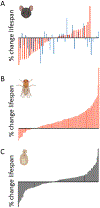Antiaging diets: Separating fact from fiction
- PMID: 34793210
- PMCID: PMC8841109
- DOI: 10.1126/science.abe7365
Antiaging diets: Separating fact from fiction
Abstract
Caloric restriction has been known for nearly a century to extend life span and delay age-associated pathology in laboratory animals. More recently, alternative “antiaging” diet modalities have been described that provide new mechanistic insights and potential clinical applications. These include intermittent fasting, fasting-mimicking diets, ketogenic diets, time-restricted feeding, protein restriction, and dietary restriction of specific amino acids. Despite mainstream popularization of some of these diets, many questions remain about their efficacy outside of a laboratory setting. Studies of these interventions support at least partially overlapping mechanisms of action and provide insights into what appear to be highly conserved mechanisms of biological aging.
Figures


References
-
- McCay CM, Crowell MF, Maynard LA, The effect of retarded growth upon the length of life and upon ultimate size. The Journal of nutrition 10, 63–79 (1935). - PubMed
-
- Osborne TB, Mendel LB, Ferry EL, The Effect of Retardation of Growth Upon the Breeding Period and Duration of Life of Rats. Science 45, 294–295 (1917). - PubMed
-
- Weindruch R, Walford RL, Fligiel S, Guthrie D, The retardation of aging in mice by dietary restriction: longevity, cancer, immunity and lifetime energy intake. The Journal of nutrition 116, 641–654 (1986). - PubMed
-
- Speakman JR, Mitchell SE, Caloric restriction. Molecular aspects of medicine 32, 159–221 (2011). - PubMed
-
- Weindruch R, Walford RL, The retardation of aging and disease by dietary restriction. (Thomas CC, Springfield, Ill., U.S.A., 1988), pp. xvii, 436 p.
Publication types
MeSH terms
Substances
Grants and funding
LinkOut - more resources
Full Text Sources
Medical
Miscellaneous

